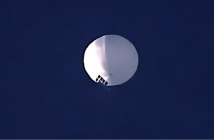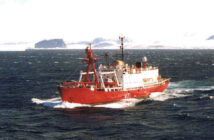Updated on Sept. 19, 2021, at 10:42 am
For many, the agreement among Australia, the United States and the United Kingdom to equip Canberra with nuclear-powered attack submarines is about sending an important deterrent signal to Beijing and fielding much-needed naval capabilities in the Indo-Pacific.
It aims to reassure those questioning whether America remains committed to its allies in the wake of Washington’s chaotic exit from Afghanistan.
The most powerful message that Washington, London and Canberra can send a determined and fast-moving potential adversary is that three allies with plodding acquisition systems can actually work together to quickly field much-needed capabilities.
If the goal is deterrence, then Sell America, Sell Britain or Buy Australia tendencies will have to be set aside in favor of pragmatic solutions.
First, although the program will be defined over the coming 18 months — and likely a national referendum on nuclear technology — training expertise needed to operate and fight complex nuclear warships will be the most time consuming.
Australian personnel must as quickly as possible be embedded at US and UK nuclear reactor training facilities and aboard US and UK nuclear submarines to start building the cadre for the new Aussie subs that will follow. Forward basing US and UK nuclear submarines in Australia will build hands on experience, as will sending personnel to BAE Systems’ cutting-edge facility in Barrow-in-Furness in northwest England.
Second, now that the ongoing program with France’s Naval Group has been cancelled, an all-new design would further delay an effort to have a new sub in service by 2026. If, however, the goal is to put a ship into service as quickly as possible to message Beijing and field a deterrent capability, it makes most sense for Australia adopt an existing design — Britain’s Astute-class that is in the tail end of production and can easily be adapted to meet Canberra’s requirements.
Developing eight unique nuclear-powered boats for Australia is madness, but increasing the Astute fleet from seven to 15 is an elegant solution that addresses Canberra’s needs while also helping UK maintain its innovative submarine industry as it shifts its focus to fielding four next-generation Dreadnought-class missile boats.
US leaders have made it clear they will support the Australian effort, but that their top priority is to increase the size and capabilities of the US Subarmine Force to maintain American warfighting and deterrence capabilities worldwide. That means fielding two Virginia-class attack subs and one Columbia-class ballistic missile sub each year, an ambitious goal that’s driving the US submarine industrial base to operate flat out without any margin of error. US officials rightly maintain they will take no action that would disrupt either Virginia or Columbia.
That leaves the Astute as the most easily executed and financially attractive option, at about $2 billion apiece in current cost terms. Rather than being optimized for strike operations as the Virginias, the Astutes are ideal for Australia’s requirements with an ability to carry torpedoes, Harpoon anti-ship and Tomahawk cruise missiles, mines as well as being optimized for special operations. Canberra needs subs that can defeat enemy ships to protect Australia and allies as well as conduct anti-submarine operations deep inside contested waters of the South and East China Seas.
And it goes without saying that the Royal Australian Navy shares much in common with the Royal Navy, from cultural to training and certification ties, as well as a long history of operation common ship designs. Australia, for example, became the first export customer for the Royal Navy’s Type 26 frigate, ordering nine of the ships. The deal is one of a myriad steps London is taking to beef up its Indo-Pacific presence, including the ongoing deployment of the new supercarrier, HMS Queen Elizabeth, which is underway in the region with the largest ever complement of stealth fighters at sea in a composite USMC-UK F-35 Lighting II air wing. Australia is buying 100 of the jets as well.
The US role in the Aussie sub program will be critical, especially in approving legislative changes to the 1958 US-UK Mutual Defence Agreement that allowed sharing of American nuclear technology with Britain. Washington shared its nuclear technology as well as the entire back end of Britain’s first nuclear-powered attack submarine, HMS Dreadnought. Forward of the reactor bulkhead, Dreadnought was all British, but aft of the reactor bulkhead was a Westinghouse S5W reactor and a Skipjack-class propulsion train. A workhorse of the Cold War, the S5W was license-produced by Rolls-Royce and remains the foundation for Rolls-Royce’s PWR2 reactor that powers the Astutes and will drive the new Dreadnoughts.
The United States should also continue to export the BSY-1 combat system, Mark 48 ADCAP torpedoes and other technologies that are already incorporated aboard Australia’s existing Collins-class submarines, and were to be included in the now-cancelled program to develop a conventional version of France’s otherwise nuclear-powered Barracuda-class submarine.
Britain should consider transferring the last of its Astute boats now in build, HMS Agincourt, to Australia in two years and then build one more ship in Barrow from scratch with intimate Australian participation, while shifting production capabilities Down Under.
What’s critical in this exercise is to bring three allies together to move quickly to delivery much needed deterrent capabilities. All decision-making must be focused on capability at speed rather than ill-considered industrial cooperation demands.
It’s encouraging that Australia reduced its domestic content requirement on the subs from 100 to 40 percent. But that industrial requirement can still prove an unnecessary complication on what will already be an extraordinarily complicated program.
It’s worth noting that France’s Naval Group repeatedly got in trouble with Australian authorities over what they saw as the French company’s reluctance to share technology and transfer capabilities to Australia’s suppliers. Some of that was for good reason. Submarines are complicated systems of systems, and it was Australian industrial demands on Sweden’s Kockums that left the Collins-class with so many original manufacturing sins that continue to plague the operational efficacy of the ships.
As with Sweden, Australia made demands of Naval Group that the company was uncomfortable with. It’s important to understand that a company with a reputation for delivering capable systems will always be reluctant to accommodate new suppliers that may not be up to scratch, in turn, undermining the efficacy of their product in the eyes of future customers.
It’s equally encouraging that Australia has concluded what analysts have long maintained — that the country’s unique requirements could only be addressed by nuclear submarines. The folly of the now-cancelled Naval Group program — valued at tens of billions of dollars — was demanding the company convert it’s highly capable nuclear-powered Barracuda into a conventionally powered vessel, while demanding of it near-nuclear performance.
Australian officials have to bear in mind that the Collins and the aborted submarine programs constitute a warning for US and UK officials and industrialists to tread carefully in entering a cooperative submarine program with Canberra.
Ultimately, Australia’s concerns with China peaked to overcome their historic concerns about nuclear power — a vestige of British nuclear tests in the country — and coincided with their frustration with Naval Group, resulting in a decision that has also incurred Beijing’s wrath.
If, as news reports suggest, France was not informed of the agreement until it was announced, it marks a major misstep among four important allies. Friends, even those with a competitive relationship, shouldn’t surprise one another on major security initiatives. Assuming Australia would inform Paris that it was cancelling the existing deal in favor of a new one with two of its Five Eyes partners is weak. The three partners had an obligation to inform the French leadership of new agreement well before the public announcement and negotiate a French role in arrangement.
Consequently, Paris is rightly enraged, accusing Washington and London of duplicity, venting ire with Canberra, with some officials vowing to wreck the deal. The decision is stinging, economically and in terms of French national prestige. Anyone who knows France knows French leaders most dread is public humiliation — being kept in the dark and made to look stupid. The pain is made worse that no one first telegraphed the punch. For Washington, you don’t solve one problem only to cause another, a worrying tendency for the Biden White House that’s playing into a narrative that it’s as unilateralist and unpredictable as its predecessor. Indeed, it’s a question of trust — how could senior French officials meet with so many of the counterparts and none of them broach the topic?
Having cancelled public engagements in Washington and for the first time, recalled its ambassador, France must maintain a sense of perspective. The nation remains a vital global security player with strategically important capabilities, including, as a sophisticated industrial partner. There are important lessons to be learned. President Emmanuel Macron and talented members of his cabinet, Foreign Minister Jean-Yves Le Drian and Defense Minister Florence Parly, deserve credit for working tirelessly to mollify mounting Australian concerns with Naval Group.
Indeed, US Navy leaders who encouraged Australia to adopt the French design as best suited for Canberra’s military and industrial requirements, given France’s key role as a submarine exporter, have also been left in a lurch.
Washington, London and Canberra must now acknowledge France’s importance not only as an ally, but also an important Pacific power, especially in helping Europe focus greater attention on the Indo-Pacific.
Therefore, the United States should negotiate with France the constitution of a new naval task group in the Western Pacific south of the Philippines that would be French led.
France has been planning an increased regional presence. One of the country’s impressive Mistral-class ships should be repositioned to French Polynesia along with several surface combatants and a nuclear attack submarine that would constitute a powerful core around which regional capabilities can coalesce.
As for Australia’s submarine program, one major challenge is that the Collins-class ships are reaching the end of their service lives. The question is whether to upgrade them, use them as is, or adopt a temporary solution until the nuclear boats arrive.
One option could be to ask Japan, a key regional ally, to transfer some of its older, but capable submarines — considered by some to be the finest conventional subs in the world — to Australia as a stopgap. As Tokyo’s industrial strategy is to replace weapons well before they age out, the Japanese boats prove an ideal solution until the new nuclear ships come on line.
If America and its allies work together, they will equip Australia with an important capability, while also making clear to Beijing that they are taking the threat seriously and are willing to make the tradeoffs necessary for success. It will take compromise and sophisticated industrial strategy.
For Australia to safely and effectively operate nuclear submarines will take time, money, hard work, thoughtful decision making and culture change. It will take all three nations working together and will take a decade or more to achieve.
But should the Australia program devolve into merely sales opportunities for companies involved with decisions driven by industrial interests rather than delivering necessary deterrence, then Beijing will understand that it retains the upper hand in this long-term competition.
In the end, it’s as much about speed as it is subs.




